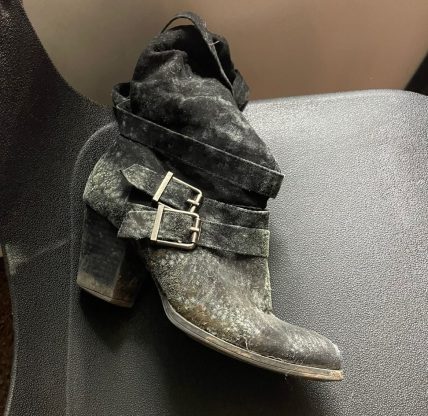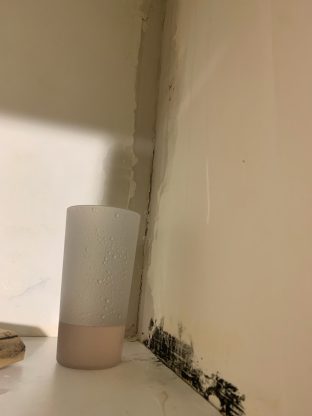
When Shauna Noordeen, a graduate political science student, moved into West Apartments I in late August, she discovered mold growing on her belongings. Soon, Noordeen felt physically ill.
Mold is one of the most common problems encountered in college dorms, and Stony Brook University is not immune to this. Students have long complained of mold in their dorm rooms, but more concerningly, have also complained about a lack of urgency from Campus Residences.
“West Apartments is a great place to live, but the long-standing problem of mold in most, if not all of their buildings is inescapable, and I only hope Campus Residences prioritizes the issue so that other students do not have to go through the respiratory issues I went through,” Noordeen said. “I had gone to the ER at five in the morning after a night of persistent coughing. At one point, I coughed up blood and my friends would not rest until I agreed to go to the ER at Stony Brook Hospital.”
Mold grows in areas with moisture and organic material. To reproduce, molds release spores, which withstand extreme conditions of acidity, temperature and starvation. Spores are invisible to the naked eye, which means while there may be no visible mold, there could survive mold spores that create mold in the right conditions.
What makes mold so troubling is its tendency to re-spread if a removal process does not remove it all. Exposure to mold can cause severe health issues, and if removed improperly, people may still be exposed to mold in drywall, even if it isn’t externally apparent.
Some of the health issues caused by mold can range from mild symptoms — such as headaches, sneezing or irritation of the eyes, skin and throat — to more severe ones, such as allergic reactions, asthma attacks, chronic sinus infections and many other issues.
Mold can weaken the immune system, as exposure to mold can trigger an immune response to fight off any inhalation of mold spores. Those who are immunocompromised are also more prone to mold-borne illness.
“The Department of Environmental Health and Safety works very closely with Campus Residences, Facilities and Student Health Services to respond to these events,” Stony Brook University officials said in a statement to The Statesman. “At Stony Brook, all complaints are responded to and assessed by staff. On-campus, most issues are easily addressed by our custodial services where cleaning of affected surfaces is required; however, in some situations, a qualified contractor is retained to address large areas or where removal of walls or large areas of flooring is involved.”
It is difficult to assess the full extent of molding within campus housing. For some students, the school’s response to fixing cases of mold has been ineffective as the mold continued to return.
Anne Green, a senior majoring in environmental design, policy and planning, was also living in West Apartments I when she discovered what she believed to be black mold and a severe leak in her closet wall.

“It felt like every which way I turned, I was ignored. It took eight weeks and two visits from Residential Operations before I could get the attention needed to clean the mold out of my closet and dry my flooded carpet,” Green said. “Despite sharing concerns of recent respiratory challenges I have been experiencing in relation to the thick black mold that had grown in my walls for months, it was dismissed as seasonal allergies.”
After Green took her frustration with social media, a few mutual friends put Green and Noordeen in contact. Soon, she discovered Noordeen faced similar issues of mold in her room. Upon learning that Noordeen became sick, Green realized that little was being done to remedy the situation.
“When I learned Shauna experienced similar environmental and health issues, I knew that this was an epidemic and an injustice to student health that needed to be addressed immediately,” Green said. “Although they were aware of both mine and Shauna’s complaints, there was no care or consideration for the negative impacts these living conditions were having on our day-to-day lives.”
According to Green, Campus Residences offered no permanent solution to prevent future floods and molding in Green’s room and offered to move her into Noordeen’s previous room, which at the time was the only other available room on campus.
Because of the severe health issues faced and a lack of adequate space, Noordeen and Green had no option but to respectively spend a few nights with their friends and at home, while still paying for their unoccupied rooms. No compensation was offered to either of them.
Green comments on how her interactions with Campus Residencies presented multiple difficulties and made it difficult for her to live on campus.
“Throughout this entire experience, I felt silenced, diminished and disrespected. It is unacceptable that I entered a $6,152 contract for a room that floods every time it rains and is a breeding ground for black mold,” she said.
Green wishes for Residential Operations and Campus Residences to “be more forthcoming with the student body,” about housing issues and “be prepared to offer resources in the event that the problem cannot be solved.”
In a survey taken by The Statesman, 70% of students disapprove of campus housing conditions.
Some schools around the country have taken drastic measures to protect student health upon discovering mold. In 2018, the University of Pennsylvania found hundreds of cases of mold, forcing student relocation. The University of Tennessee had to evacuate 600 students due to mold in 2018.
“It is upsetting that despite knowledge of my living conditions and my limited options, the University is comfortable leaving me there,” Green said. “The University needs to be proactive and fix this issue before it envelops the entire building and jeopardizes the health of all its residents.”






















